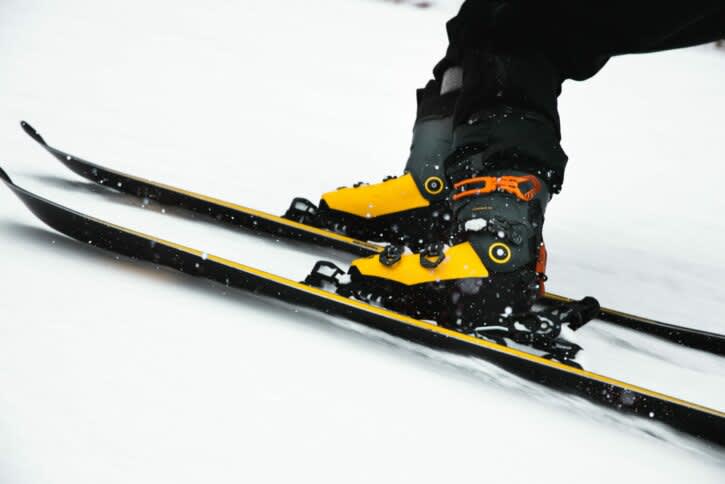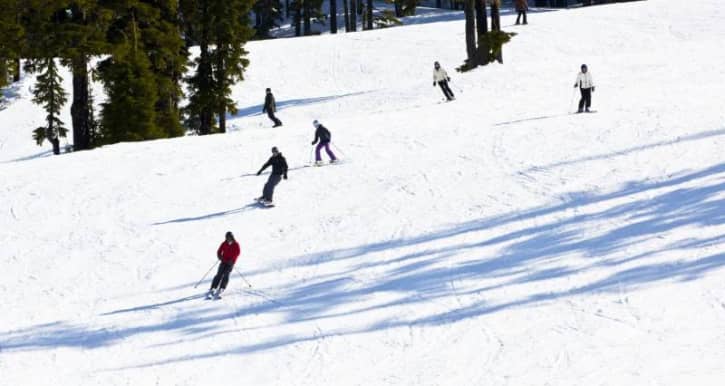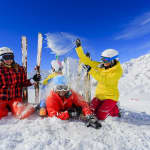Many people wonder if knowing how to ice skate will help with learning to ski, which is an excellent question. The short answer is: it absolutely helps to a very large degree.

As someone who played ice hockey my entire childhood and then first went skiing in high-school, I feel uniquely qualified to answer this question.
Here was my experience learning to ski after knowing how to ice skate:
Contents
An Ice Skater’s First Time Skiing (What Came Easy)
The first time I went skiing was on a Friday night ski trip with my high school. I didn't own skis at the time, and I wasn't really sure what to expect. When I first put the skis on, two of my buddies and I went to test things out on the bunny hill. They had both been skiing a bunch of times, but we still wanted to warm up since they hadn't gone in a while.
The first thing I noticed was that it required a fair amount of conscious effort to keep the ski tips from crossing. I didn't take a formal lesson, but a few people mentioned that I should try to make a pizza or half-wedge with the tips in order to stop and turn when I first started.
However, I felt far more comfortable with doing a hockey stop right from the get-go. It didn't feel all that different, aside from the fact that the skis were far heavier. The motions for the hips, hamstrings, and glutes were all kind of the same. The only difference I could describe is having to lift the skis a bit more when doing a hockey stop.
After I realized that I could stop easily, I had a lot of confidence. Controlling speed and direction on the mountain to me felt like doing little hockey stops from side to side while making sure not to cross the blades. People who learned to ski first would probably describe it differently, but that's how it felt to me the first time.
A few hours in, I felt pretty comfortable on the harder trails. This was a rather tiny mountain, so the black diamond trails weren't as overwhelming or as steep as the ones on the big mountains, but either way, I was pleasantly surprised that my previous experience had come in handy.
Knowing how to stop on skis should come pretty naturally to an ice skater. This is huge and should get you through many of the easy and intermediate ski trails.
Okay enough tooting my own horn -- what about the hard parts? Just because stopping will most likely come easy, doesn't mean that learning to ski will be a cakewalk.
Here are some of the things I struggled with...
Stability When Going Fast (Struggle #1)
The one aspect that an ice skater should be prepared for is the lack of stability when going fast. Learning to stop on the bunny hill will seem really easy, but it's easy to get a bit uncomfortable once you start picking up more speed than you can handle. Your skis can begin to cross, and things can start to feel out of control.
There isn't anything from ice skating that's directly translatable to handling the speeds you can reach on skis. On ice skates, you generate most of your power. With skis, gravity does all of the work.
The main thing to remember is that stopping remains virtually the same. If you can keep your skis parallel, you should be able to stop or greatly slow yourself down with that hockey stop. This should give you enough confidence to work on increasing your speed, but don't bite off more than you can chew on your first day.
Center of Gravity (Struggle #2)
Center of gravity is something that ice skaters also might find quite awkward at first. When ice skating, your center of gravity remains pretty much the same when trying to generate movement. You have bent knees, your butt is low, and you stride with as much power as possible on a flat surface.
On skis, your center of gravity has to change depending on the situation. There are times where you need to keep your weight centered, but there are other times when you need to lean forward or back.
This was something I had a passing-by ski instructor point out to me. Hence why I highly recommend getting a lesson.
Pointing Ski Tips & Skiing in Powder (Struggle #3)
When you start in heavy powder, pointing your ski tips up is important. If you don't, your skis can get buried, so you'll lose all your momentum and potentially fall. This took me quite a while to get a feel for.
In fact, skiing through tons of powder was probably the hardest thing for me to pick up when beginning to ski, and it still remains kind of a struggle today.
Conclusion
Most people who are proficient at ice skating will have a huge advantage when they hit the slopes. Learning to use your edges is the hard part for a lot of people, and if you've skated, you already have a good idea how to do that. Just don't get too overconfident your first few times out and get more speed than you can handle. And don't shy away from taking a lesson -- even if feel like you know what you're doing.
Pssst... Have you thought about what you're going to wear your first time on the slopes to stay warm?
If not, you need to check out the following guide:






